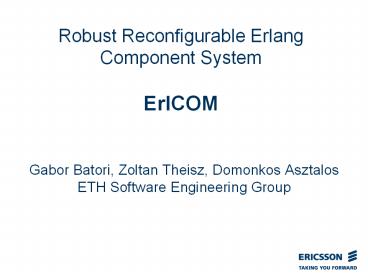Robust Reconfigurable Erlang Component System ErlCOM - PowerPoint PPT Presentation
Title:
Robust Reconfigurable Erlang Component System ErlCOM
Description:
Title: Robust Reconfigurable Erlang Component System ErlCOM Description: Rev PA1 Last modified by: Ericsson User Created Date: 10/26/2004 9:20:03 PM – PowerPoint PPT presentation
Number of Views:98
Avg rating:3.0/5.0
Title: Robust Reconfigurable Erlang Component System ErlCOM
1
Robust Reconfigurable Erlang Component
SystemErlCOM
- Gabor Batori, Zoltan Theisz, Domonkos Asztalos
- ETH Software Engineering Group
2
Why?
- Robust
- Fault tolerant, Highly available
- Reconfigurable
- Adaptability to environmental changes
- Erlang
- Ericssons preferred language ?
- Component
- Separation of functionality
- Structured, reusable code
- System
- Application neutral framework
3
Component Model
- Component, Composite Component Functionality
Owner - Interface, Receptacle Interaction Point Owner
- Binding Communication Owner
- Component Framework Constraint Owner
4
Robust Component Model
- Capsule Supervision Owner
- Caplet Component Owner
- Component Functionality Owner
5
Reconfiguration
- Reactive behavior
- Due to environmental changes (switch-over)
- Due to HW/SW faults (fail-over)
- Implementation
- Reflectivity (observable)
- Operational Facility (dynamic reconfiguration)
6
Basic concepts
Concept Erlang ErlCOM
Concurrent entity Process Component
Communication Message Passing Binding
State Local state information Reflective Repository
- No reasoning about messages
- Interception consists of pre/post actions ?
synchronous communication
7
RUNES Example
- Gateways represented by Capsules (running Erlang)
- Middleware and Application Component Frameworks
using the services of the Ubiquitous CRTK
8
Erlang Mapping
- Component ? gen_server
- Interface/receptacle ? gen_server
- Binding ? gen_server
- Pre/post action ? process
- Capsule ? erlang node, gen_server
- Caplet ? gen_server, supervisor
- Reflective Repository ? mnesia
- CRTK ?module (floating reflective API)
9
Implementation details(1)
- Entity Relationship Diagram (ERD) generated
Erlang Code
10
Implementation details(2)
- Message Sequence Chart (MSC) Erlang Code (CRTK)
11
What we have learnt?
- Entity Relationship Diagram helps identify
concepts - MSC helps describe dynamics
- Erlang provides versatile platform for component
based systems - Current implementation provides a feasible proof
of concept for RUNES CRTK. - BUT, the implementation code is COMPLEX
12
How to reduce complexity?
- Custom libraries (API design)
- Code maintenance problem (version handling)
- Custom behavior (language design and virtual
machine) - Too intrusive , too costly
- Generative Programming (meta-modeling, modeling
and transformation design) - New design approach ? Domain Specific Language
engineering and supporting IDE needed
13
Our solution
- Development cycle
Translator (Erlang Templates)
ERD,MSC
Generates
ErlCOM Structural Description
Application Code (Erlang)
Application (Erlang)
14
Generic Modeling Environment (GME)
- NOT object-oriented, NOT UML
- Supports multi domain modeling
- Meta-model aware graphical editor
- Supports transformation frameworks
- Freely available, Open Source, BUT industry
quality - Perfect match to Erlang ?
15
Conclusion
- ErlCOM extends Erlang with new abstractions (like
OTP) - ErlCOMs Component System provides adaptive
behavior to Erlang applications in Run-Time - ErlCOMs GME IDE allows design abstraction driven
Erlang code production in Development-Time - Should not be used in application development
where the Erlang abstraction level is perfectly
sufficient (ErlCOM is a component based adaptive
extension)































